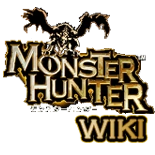|
In-Game Information[]
An enormous, wasp-like insectoid with a poisonous stinger that paralyzes prey. Easily damaged, there are rarely any usable parts left to harvest from them once they are killed.
Taxonomy[]
- Order: Shell Insect
- Suborder: Hario
- Family: Vespoid
- Species: Vespoid
Vespoid are flying Neopterons controlled by their larger queen, the Vespoid Queen.
Habitat Range[]
Vespoid can be found living in Forest and Hills, Old Swamp, Old Volcano, Volcano, Tower, Gorge, Highland, Jungle, Dawnwind Valley, and Ancestral Tomb.
Ecological Niche[]
Vespoid are simple workers to a single large Vespoid Queen. They come in two varieties. The small worker Vespoid is charged with gathering food, maintaining the hive, and caretaking the queen and her eggs. The large, sturdier soldier vespoids exist for the sole purpose of defending the queen. They will frequently attack any intruders, no matter how large or small. Their stingers don't penetrate the thick shells of most wyverns, but pose a significant deterrent to humans and Fanged Beasts alike.
Biological Adaptations[]
Vespoid have developed very durable body structures. Their wings can carry their light frame great distances in search of food, and their tough exoskeleton protects them from some attacks. This shell also to helps to offer the small creature protection from any climate. Vespoid have a nasty stinger that injects its foes with a paralyzing toxin. Their main defense and weapon is their huge numbers. By staying and working together, it decreases their chances of being eaten and increases their chances of taking down larger prey.
Behavior[]
Vespoid can be nuisance alone but, hazardous in greater numbers. They sting a lot to take down prey, paralyzing prey before cutting it into pieces, and bring it back to their nest. If it is small prey, they just sting it and carry it back to the nest themselves. If the colony becomes too large, they will divide into smaller colonies throughout an area, not to far away from the main colony.
